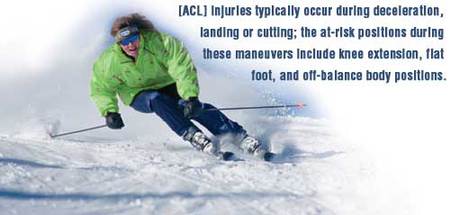Taking care of female athletes
Consensus statement on female athlete medical issues released by sports medicine groups.
A consensus statement recently released by a collaboration of associations outlines several musculoskeletal and medical issues specific to female athletes and the related implications for prevention and care.
The document, intended as a guide for team physicians, was developed by the American Orthopaedic Society for Sports Medicine, American Academy of Orthopaedic Surgeons, American Academy of Family Physicians, American College of Sports Medicine, American Medical Society for Sports Medicine, and American Osteopathic Academy of Sports Medicine.
John A. Bergfeld, MD, at the Cleveland Clinic and a member of the consensus panel, said the statement represents “fresh new data based on good research, not just personal opinion.” He said the real value of the consensus statement would be increased awareness about the gender-specific issues related to female athletes.
“We are trying to increase awareness that there is a little bit more to think about with female athletes,” he said.
Edward J. Wojtys, MD, editor of Orthopedics Today's Sports Medicine section, said that it “has been become clear that the female athlete is different from the male athlete. Nutrition, training, health issues all need to be addressed in a gender-specific manner, and recent research has supported that.
“In the past, training of female athletes was conducted the same as for male athletes. That clearly was not the right approach,” Wojtys said.
According to Carol Teitz, MD, of the University of Washington, “The consensus statement is important in that it concisely organizes the key issues regarding care of the female athlete. Because it is a consensus statement derived by a knowledgeable, respected group, it highlights what is agreed upon and omits what is still being debated.” Teitz is a member of Orthopedics Today's Sports Medicine section.
The consensus statement addresses several issues, with recommendations about screening and training:
ACL injuries
|
Females are at increased risk of ACL injuries, with the highest risk imposed by basketball, field hockey, lacrosse, skiing and soccer.
The noncontact ACL injury rate among athletes is two to 10 times higher in females. These injuries typically occur during deceleration, landing or cutting; the at-risk positions during these maneuvers include knee extension, flat foot, and off-balance body positions, according to the statement.
The team physician should know how to evaluate and treat an ACL injury. Prevention measures are essential, including understanding that conditioning programs should be gender specific.
Bergfeld said that prevention measures could help cut down on the incidence of ACL injuries among female athletes. “Females have a higher incidence of ACL injuries, so if we try to intercede with the younger athletes, we can teach them appropriate balance techniques.” Bergfeld is a member of Orthopedics Today's Sports Medicine section.
Patellofemoral joint
Patellofemoral pain and dysfunction, resulting from macro- and micro-trauma, occur frequently in female athletes. According to the consensus statement, risk factors include malalignment of the pelvis, hip, knee, ankle and foot; muscle weakness and/or imbalance and inflexibility; altered patellar position and/or morphology; and trauma, overuse and/or training errors.
As with other types of injuries, the consensus document recommends the identification of risk factors during the evaluation prior to sports participation and the implementation of a screening program for risk factors.
Shoulder conditions
High-risk sports related to shoulder injuries in females are diving, gymnastics, swimming, tennis, throwing sports and volleyball. These injuries, the result of both macro- and micro-trauma, can follow imbalances in strength and flexibility or injuries elsewhere.
Female athletes are at risk for shoulder injuries due to increased biomechanical load resulting from increased joint laxity, increased muscle and joint flexibility, decreased upper-body strength and poor posture, and acquired internal rotation deficits.
Stress fractures
Although stress fractures occur frequently in female athletes, there is little evidence that there is a gender-specific difference among trained athletes.
There are multiple risk factors associated with stress fractures, including the type and intensity of exercise; footwear; limb alignment; or presence of osteopenia, osteoporosis, menstrual dysfunction, poor nutrition, and disordered eating.
Osteoporosis, eating disorders
Osteopenia and osteoporosis can be present in young female athletes and can affect athletic performance. Risk factors are disordered eating and menstrual dysfunction. Tobacco use, excessive alcohol consumption, renal disease, hyperparathyroidism, and medications such as glucocorticoids can also affect bone density.
According to the consensus document, team physicians should understand the risk factors, as well as the criteria for osteopenia and osteoporosis.

Risk of developing an eating disorder is greater for athletes in sports involving aesthetics, endurance and weight classifications, such as ballet, gymnastics and long-distance running. Fifteen percent to 62% of college female athletes have a history of the problem, and they are at higher risk for developing an eating disorder than the general population.
These disorders can lead to electrolyte disturbances, decreased bone mineral density, gastrointestinal problems, cardiovascular abnormalities and psychiatric problems. The consensus statement urges physicians to understand the importance of prevention and early detection.
Menstrual dysfunction, pregnancy
The team physician should understand the consequences of menstrual dysfunction on bone mineral density and fertility, according to the consensus document. Bergfeld noted that information is incomplete about how menstrual dysfunction affects sports activity and hormone levels, but new research is looking at its effect on bone health.
In athletes, menstrual dysfunction is two to three times more common than in nonathletes. Ten percent to 15% of athletes have amenorrhea or oligomenorrhea, which can lower estrogen and/or progesterone levels and lead to lower bone mineral density and a higher incidence of stress fractures and infertility.
Even though most team physicians do not provide obstetrical care or provide contraceptive counseling, they should coordinate and collaborate with the athlete’s obstetrician/gynecologist in the management of sports-related injuries and illnesses when appropriate.
The consensus statement notes that use of injectable depot medroxyprogesterone acetate may lead to amenorrhea, lower estrogen levels and decreased BMD.
The complete consensus statement is available at www.sportsmed.org.
